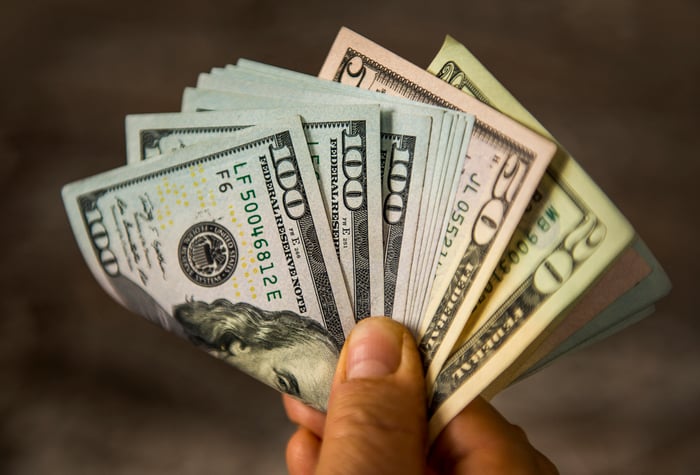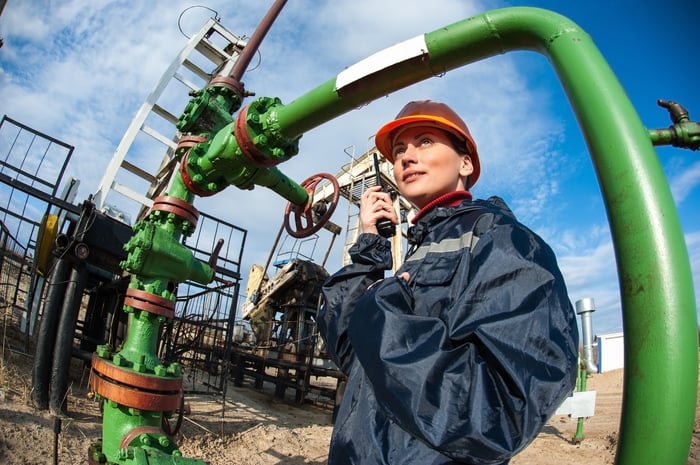When the curtain closes on 2022 in roughly two and a half months, Wall Street professionals and everyday investors are likely to look back on this year as one of the most trying on record. Since the ageless Dow Jones Industrial Average, all-encompassing S&P 500, and growth-driven Nasdaq Composite hit their respective all-time highs, they've all, respectively, plunged firmly into a bear market.
On one hand, the rapid declines that accompany bear markets can test the willingness of investors to stick around. On the other hand, history has conclusively demonstrated that putting your money to work during these downturns is a genius move. That's because every double-digit decline in the major U.S. stock indexes has eventually been put into the rearview mirror by a bull market.
In other words, the real challenge for investors right now should be figuring out what stocks to buy. Arguably the best answer might be dividend stocks.

Image source: Getty Images.
Dividend stocks offer plenty of promise but can also have a dark side
Companies that pay a regular dividend to their shareholders almost always have transparent long-term growth outlooks and are profitable on a recurring basis. What's more, they're typically time-tested, which means they've navigated their way through an economic downturn before.
But the best aspect of income stocks is their long-term outperformance. Nine years ago, J.P. Morgan Asset Management issued a report that compared the 40-year returns of companies that initiated and grew their payouts between 1972 and 2012 to companies that didn't offer a dividend. Over four decades, the dividend stocks delivered an annualized return of 9.5%, which compared quite favorably to the non-payers that trudged their way to an average annual return of just 1.6%.
However, no two dividend stocks are alike. Although income investors would like the highest yield possible with the least amount of risk, studies have shown that risk and yield tend to go hand-in-hand when payouts top 4% (i.e., high-yield status). Since yield is a function of payout relative to share price, a struggling business with a falling share price can lure unsuspecting investors into a yield trap.
Thankfully, not all high-yield income stocks are bad news. What follows are two high-yield dividend stocks that investors can confidently buy hand over fist, as well as one high-yielder they'd be best off avoiding like the plague.
High-yield stock No. 1 to buy hand over fist: Walgreens Boots Alliance (5.8% yield)
The first supercharged income stock that's a screaming buy for value-oriented investors is pharmacy chain Walgreens Boots Alliance (WBA -0.93%). Walgreen's is a Dividend Aristocrat that's raised its base annual payout in each of the past 47 years. Its nearly 6% yield marks its juiciest payout on record.
Normally, healthcare stocks are viewed as highly defensive, and are therefore fairly immune (pardon the pun) to recessions and economic downturns. But in Walgreens' case, the initial stages of COVID-19 lockdowns decimated foot traffic into its brick-and-mortar retail locations. Because the company is so reliant on its physical stores, its bottom line took a direct hit. But where there's pain, there's often opportunity.
For years, Walgreens Boots Alliance has been undertaking a multipoint turnaround strategy that's focused on increasing its operating margin, lifting its organic growth rate, and improving customer loyalty. In virtually all aspects of its strategy, the company appears to be on track or ahead of schedule.
For example, the company ended fiscal 2021 (Walgreens' fiscal year ends on Aug. 31) having reduced its annual operating expenses by more than $2 billion. That was more than expected, and a full year ahead of schedule.
But Wall Street is far more interested where Walgreens Boots Alliance is spending its money than where it's cutting costs. In this respect, it's aggressively spent money to upgrade its direct-to-consumer platform, as well as partnered with (and invested in) VillageMD to open as many as 1,000 co-located, full-service health clinics by the end of 2027. Having a larger online presence should boost its organic growth rate. Meanwhile, offering physician-staffed clinics provides an impetus for customers to frequent their local Walgreens.
Valued at just 7 times the midpoint of its forecast earnings for fiscal 2023, Walgreens is historically cheap.

Image source: Getty Images.
High-yield stock No. 2 to buy hand over fist: Enterprise Products Partners (7.6% yield)
The second high-yield dividend stock that can be bought hand over fist by income-seeking investors is energy stock Enterprise Products Partners (EPD -0.31%). Enterprise is working on a 24-year streak of increasing its base annual payout, and has the highest yield among the companies discussed here at 7.6%.
Understandably, some investors aren't going to be thrilled about the opportunity to invest in oil and gas stocks. It was just 2-1/2 years ago that oil and natural gas demand fell of a cliff during the initial stages of the pandemic. During a very brief period, West Texas Intermediate (WTI) crude oil futures contracts traded at negative $40 per barrel. This chaos is still fresh in the minds of a lot of investors.
However, Enterprise Products Partners is a different beast entirely. Whereas upstream drillers and explorers ebb-and-flow with energy commodity prices, Enterprise is a midstream operator. In simple terms, this means it's an energy middleman. It operates the transmission pipelines, storage tanks, and processing facilities that helps crude oil and natural gas get from the production fields to refineries.
The beauty of energy middleman like Enterprise Products Partners is that they almost always rely on long-term, fixed-fee or volume-based contracts. These contracts remove spot-price vacillations and inflation from the equation and allow midstream operators to accurately forecast their operating cash flow in any given year. Cash flow forecasting is important, since it allows a company like Enterprise Products Partners to set aside capital for new infrastructure, acquisitions, and its distribution, without impacting its profitability.
Something else to note about Enterprise is that its distribution coverage ratio (DCR) never fell below 1.6, even when WTI futures contracts turned negative. The DCR is the amount of distributable cash flow from operations relative to what was paid to shareholders. A figure of 1 or below would imply an unsustainable payout.
Currently valued at less than 10 times Wall Street's forecast earnings per share for 2022 and 2023, Enterprise Products Partners has the look of a no-brainer buy.
The high-yield income stock to avoid like the plague: Kraft Heinz (4.5% yield)
But not all high-yield dividend stocks are worth buying. Packaged food and beverage behemoth Kraft Heinz (KHC -0.21%) is the perfect example. Kraft Heinz offers a market-trouncing 4.5% yield, but the company did slash its quarterly payout from $0.625 to $0.40 in 2019.
Usually, the consumer staples sector represents a safe, if not boring, place to put your money to work. It's an especially attractive sector during bear markets given that people still need to eat and drink, no matter how poorly the stock market performs.
The company also notably benefited from the pandemic. During the height of the pandemic, fewer people were going out to eat. This gave Kraft Heinz an organic boost, with consumers choosing to eat more of its easy-to-prepare meals and snacks. But this is where the fairy tale ends.
What was once a tailwind is set to become a significant headwind for Kraft Heinz. With the worst of the pandemic now in the rearview mirror, people are beginning to return to their normal activities. Couple this with historically high food inflation, and the table is set (I know, another bad pun) for shoppers to either trade down from pricier Kraft Heinz meals, beverages, or condiments, or possibly eat out more often. Wall Street's expectations reflect this shift, with Kraft Heinz's sales expected to be virtually unchanged from 2021 in 2022 and 2023.
Another issue for Kraft Heinz is its balance sheet. Heinz's grossly overpriced acquisition of Kraft Foods in 2016, among others transactions, has left the company with a mountain of long-term debt and goodwill. As of June 25, 2022, $31.2 billion of the company's total assets was "goodwill," and it had almost $20.9 billion in long-term debt.
Ideally, Kraft Heinz needs to reinvest in its brands to reinvigorate long-term interest and build loyalty with its customers. But with just $1.5 billion in cash and cash equivalents, it simply doesn't have the capital in place to really ignite organic growth.
Though Kraft Heinz is relatively inexpensive on a forward-earnings basis (13 times Wall Street's fiscal 2023 earnings forecast), its lack of sales growth and burdensome balance sheet make it wholly avoidable.





